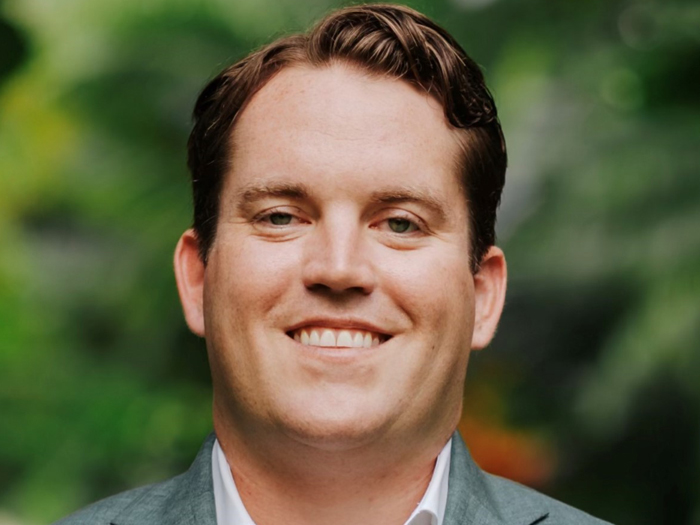8 Questions for Nan-Wei Gong and Scott Sexton of FIGUR8

In late summer, Dan Reynolds, the editor-in-chief of Risk & Insurance, got the chance to catch up with Nan-Wei Gong, the founder and CEO of FIGUR8, and the company’s president and chief business officer, Scott Sexton. What follows is a transcript of that discussion, edited for length and clarity.
Risk & Insurance: I thought I would start by asking Nan-Wei about the origins of the technology and details about the company’s business model and how it fits into the workers’ compensation ecosystem. Does that make sense?
Nan-Wei Gong: Absolutely. I was thinking about this and how we are unique coming into the industry combining experts in digital health, medical technology innovation and insurance. Most of the innovation that happens in the insurance industry starts by people like Scott, experts in insurance.
Most insurance innovation has the same value proposition: to reduce costs and provide better services for customers. Where I come in and why this is such a powerful combination, between my expertise and Scott’s, is that we bring best-in-class musculoskeletal analysis technology and data into the insurance decision matrix.
The power of this data for the workers’ compensation industry is pivotal since this is one of the remaining guesswork variables that brings high uncertainty to the financial outcome. Together, we revolutionize how musculoskeletal (MSK) claim decisions can be optimized with real data captured by an injured workers’ treating medical team.
I have a PhD from MIT and my background is in sensor technology. The genesis of FIGUR8 goes back to 20 years ago when we started developing wearable computers at Massachusetts Institute of Technology (MIT). There was a lot of collaboration between major league sports teams, Mass General Hospital and MIT on creating technology that could improve professional baseball players’ biomechanics for injury prevention and recovery plan optimization.
Everyone in pro sports is always on the lookout for an edge. The investment in science-driven data analytics built into the ecosystem of players’ development led to the glorious winning streak for Boston teams.
The motion capture setup for teams like the Boston Red Sox was traditionally a room surrounded by high-speed cameras. It takes two to three hours per person to be assessed and a few days after to generate meaningful data with a powerful supercomputer and a clinician who understands biomechanics.
And that review might say, “You should stop pitching this way. Here’s how you improve your training so you’re more effective.”
So, that’s the technology today for elite athletes. We know that the science is there, the knowledge is there and the benefit is obvious. People are trained and educated to read the data and give insights on injury recovery and performance optimization. But that level of musculoskeletal data insight is just not available for everyone else.
We started FIGUR8 to combine my expertise in wearable technology and understanding and connection with the biomechanics sports science field to create a lab-to-field experience, a “biomechanics lab in a box.”
What that really means is that we are able to take a room full of equipment and fit it into a portable form. We add the software and machine learning, artificial intelligence layer so that the expertise of a biomechanics or sports science expert can be summarized into a very comprehensive but also digestible package.
That’s the concept. We started the company and invested $20 million in developing the technology. It took us five years to get to the point where it is now: a commercially available product.
Our goal and mission is to solve a big challenge in health care, starting with workers’ comp — that [challenge] being understanding injury recovery precisely such that providers, payers and injured workers can communicate progress in a codified language.
The combination between my background and Scott’s background, we feel, makes us ideally suited to solve the problem of guesswork in the management of musculoskeletal care. It’s a critical need, and we’re excited to be part of the solution.
R&I: Thanks for that. Which professional in the workers’ comp system is most likely to use this product?
Scott Sexton: Happy to jump in here. I was introduced to Nan-Wei by the chief medical officer of FIGUR8. At the time, I was working on a unified claimant risk-scoring model.
Prior to coming on board FIGUR8, I worked at CorVel for over 18 years. At CorVel, we had a rich combination of claims, case management, bill review, pharmacy benefit management and utilization review data. We developed some of the most advanced clinical modeling tools with claims and PBM data.
I was working with our team to be able to understand (since most of workers’ comp injuries are musculoskeletal) how do we know whether the patient is actually physically improving?
I asked our staff that, and what I heard was crickets. “We don’t have that,” I was told.
My response was, “What do you mean ‘We don’t have that?’ ”
We’ve got physical therapists, and they’re doing this tremendous work, but we’ve never been able to standardize and objectively codify the data as to the patient’s physiologic recovery. There are certainly some elements that are codified, like restrictions and return-to-work, but the tools and methods used to determine those decisions are largely based on human observations, which aren’t consistently reproducible between providers. It’s certainly expert observation, but the tools that have been used to track injury recovery progress haven’t advanced in decades.
That’s where I got introduced to FIGUR8 and the ability to quickly and easily capture this type of accurate, objective and precise data that has been lacking. In fact, one of our clinical advisors, who is the executive chief of orthopedic surgery for a large health system in New England, stated, “What you are doing at FIGUR8 is groundbreaking. We’ve never had a tool we can use in-clinic to consistently, accurately and objectively reproduce injury recovery progress data.”
One of the additional things I learned early on is that the typical go-to-market strategy for technology of this type is a hardware SaaS model. You would essentially package and sell this “biomechanics lab in a box” that Nan-Wei and her brilliant engineering team has created to a health care provider, and then you’d sell a subscription software service. The average time to introduce a new technology to the time you get broad-based adoption is about 17 years. So I started thinking, all right, how do we accelerate that process? How do we get into the existing ecosystem faster?
We wanted to be able to plug this in to those already doing the physical examination. We could have worked with an orthopedic surgeon or an occupational medicine doctor, and they could have a biomechanics lab right next to their X-ray or their CT scan or their MRI.
Then we started talking to physical therapists.
The physical therapists are already conducting a physical examination of a patient and doing so on a regular basis as part of the injured workers’ recovery. So instead of reinventing the wheel and creating a new lab and technician, we thought it would be more effective if we augmented the existing physical examination that a physical therapist is doing with our technology and have it become part of their standard of care.
An additional issue with any go-to-market strategy in the health care environment is resolving the provider reimbursement model. The traditional model is leveraging an existing CPT code, so providers are able to be reimbursed.
After we completed a CPT code landscape survey, including with the assistance of the American Medical Association, we jointly determined a new CPT code was required for the use of our technology, as nothing like this existed in the market.
However, for any new technology, the American Medical Association grants a Category III CPT code, which requires advance authorization by payers — unlike Category I CPT codes, which have a defined value.
Since our provider partners had no way to be reimbursed for using our technology without our support, we told our provider partners that we would perform the payer contracting on their behalf. But we not only wanted to administer the contracting for this proprietary CPT code — we wanted to take this opportunity to elevate the entire industry by providing value not just to that provider to be able to provide better patient-centric care to their patient, but to the payer as well.
We wanted to determine how we could take this unique data and also provide valuable reporting back to the payer and increase the level of trust and communication between that provider and the payer. Essentially, how do we elevate the entire ecosystem on behalf of the injured worker, the provider and the payer simultaneously?
We had worked to create a service suite that served the physical therapist to be able to treat the patient more efficiently and effectively. What we have also been working on is to create a data report that serves the payer simultaneously so that it helps them make claims-related decisions.
There are all of these common decisions that need to be made in a workers’ compensation claim that are largely based on medical guesswork. For example, there are very talented people that are making medical necessity determinations, but they are reviewing those decisions against a guideline. And as you know, industry guidelines are based on the average, but there’s no such thing as an “average” patient.
As an example, let’s say that you need six physical therapy visits for your condition. Let’s say I have the same condition, but I need 18 visits to fully recover because I’m deconditioned. So we both get 12. That’s our model. How is it that we can have a model that says “No, Dan needs six PT visits, as he’s healthy; Scott needs 18 because he has some challenges and it’s going to take him longer to recover”?
So, we enable much more patient-centric care as opposed to having a cohort of individuals that’s underserved and having a cohort of individuals that’s overserved.
R&I: Appreciate that, Scott. Nan-Wei, is there more you wanted to add to what Scott gave us around who is going to use the tool?
NWG: We started with the physical therapist, and that is just the entry point, because someone needs to administer the test, especially when you are bringing a technology into the market. But there are other touchpoints in our health care chain that this type of exam can assist, such as a primary care physician or an orthopedic physician.
While our entry point is at the physical therapy clinics on the data side, everyone has something to benefit from having objective data.
Speaking as a patient myself, I get very, very motivated when I can see my progress in this category of medicine — there is just no progress report. You keep going back to your physical therapist and not knowing whether you’re doing better or not.
R&I: So this is something that sits with the physical therapist in the main, for starters; it’s recording data in real time, then we can get that data to the payer so they can act on that data. It sounds like this is a tool that’s going to alleviate pressure on adjustors, because instead of going back and forth with five or six emails or letters, you’re getting that data communicated right to the payer and the adjuster much more quickly than before.
NWG: Absolutely.
R&I: Speaking of data, what kind of reception are you getting from payers or providers so far?
SS: We have been very focused on our go-to-market strategy and working with a number of state insurance funds, regional insurance carriers and TPAs that have concentrations of musculoskeletal claims in certain geographic areas, allowing us to optimize our team’s bandwidth and resources.
And we have done just that, with a couple dozen contracts executed over the course of the past several months that include a combination of state insurance funds, from those like the Wyoming Department of Workforce Services to CompSource Mutual to MEMIC.
It also includes regional insurance carriers like Western National, Old Republic BITCO and Benchmark Administrators. It also includes third-party administrators (TPAs) — both TPAs that have a larger concentration of volume in a geographic area, like JWF in Indiana and Risk Administration Services in South Dakota, as well as some of the national firms like CCMSI.

Scott Sexton, president and chief business officer, FIGUR8
We have had some really nice feedback and adoption on the payer side. How we have approached the providers is that we work with our payer clients to identify the physical therapy firms they are already working with and that are already delivering the care on behalf of their injured workers.
At FIGUR8, we appreciate that there is a technology innovation adoption curve where some organizations are innovators and early adopters, while other organizations will be slower to come on board. We do have two of the top 10 physical therapy firms in the country already heavily engaged with us, and we’re working rapidly to implement a couple thousand contracted clinics, from local one-to-two-clinic firms to firms with several hundred locations.
In fact, one of the top 10 physical therapy firms has already indicated that we have become part of their standard of care for workers’ compensation within their clinics where we have implemented. So, we feel really good about what we have accomplished in a short period of time, both in the progress on the payer side as well as on the provider side.
But we also appreciate that we have just started implementing clinics as of January of this year, 2023. We are already in 15 states across the country and we are being very deliberate with the specific clinics we enable. For example, one clinic organization has a couple hundred clinics and we are live in 25 of them. Another organization has 1,200 and we are live in a couple dozen with them. We are just getting started.
R&I: Nan-Wei, you mentioned the old-school method of multiple cameras in a room and it taking hours to record data. How is your technology working? Are you placing it on the injured knee? Is it sitting on a table and picking up movements from the patient? Please help me understand how it works.
NWG: We measure the three most important components of musculoskeletal health and injury recovery: the mobility of individual joints; the biomechanics of multiple body segments, meaning how one part of your body will affect the others; and the health of your muscle function.
In order to reconstruct the complexity of the musculoskeletal system, we designed an on-body sensor system, just like how a series of sensors are needed in ECG to get the full picture of your heart’s function.
The placement of these sensors is based on the segment of interest. For example, if we are interested in measuring a knee injury, we have sensors placed on both legs to measure and compare the mobility and function of your injured knee with your healthy knee and the mobility and function of a normal knee from our database. The same sensors can compare the muscle function such as your capability, stability and deficit based on activity phases.
A clinical example would look like the following: If you have an ACL tear, your knee will be wobbly from the lack of stabilizing ligaments and have movement that deviates from a normal knee.
The instability both shows in joint mobility and affects your biomechanics, such as how you walk.
Lastly, during the recovery from an ACL injury, your muscles tend to weaken and need to regain strength and function.
FIGUR8’s system captures all three important metrics that can best represent the recovery of a MSK injury.
We have different programs specific to the most common injuries — a knee program, back program, and neck program et cetera — and the sensors are placed around the segment that matters the most to create full biomechanics reconstruction for everyone to understand the areas to focus on tracking longitudinally.
What we bring to the table is a suite of medical-grade measurement devices and services with a consumer-facing design philosophy, which is particularly important for us as a company. We thrive at reducing as much friction as possible so everyone can participate and benefit from our solution.
R&I: You mentioned progress. A carrier CFO might ask, “Where is my return on investment if I contract to have our providers use this product?”
SS: One of the people that we brought on board early on as an advisor was Steve Novak. Steve was the former chief claims officer for Benchmark Insurance. To your point, I wanted feedback from someone who’s been in that role as to what is valuable to them.
As we talked through the possibilities of the technology, one of the projects that Nan-Wei had worked on was with MAPFRE Insurance. MAPFRE is a large insurance carrier on the East Coast. As you know, they’re also the largest auto insurance carrier in Europe.
One of their biggest challenges was, how do they determine whether someone has a mild to moderate whiplash injury versus whether they’re healthy? So Nan-Wei entered into a research project with that group to be able to detect exactly that — being able to detect healthy versus injured.
Through the data, Nan-Wei’s team was able to go beyond determining the extent of the injury and was able to determine exactly which side of the vehicle was hit through the biomechanics of the whiplash injury. It was that high a level of granular detail, but the most compelling data point to come out of that work was the reduction in the amount of time for recovery.
What we learned was that when you have accurate and objective data, there is a level of precision that the health care provider can provide to the care plan that was able to reduce the overall duration of care by one-third.
What we did was essentially extrapolate that to the United States market for workers’ compensation. Firms are telling us, “If you could help us reduce the duration of the claim, that’s material, because it’s not just a function of even the cost of the claim, it’s also the carrying cost of keeping that claim open.”
While we appreciate that there are industry concerns regarding the levels of spend on physical therapy, and that’s an important consideration, that hasn’t been the primary focus of our clients. The primary focus is optimizing the treatment so the injured worker gets what they need to recover faster.
Our clients share that what is most important to them is making sure the treatment delivered is effective, the injured worker is returning to work as quickly and safely as possible without unnecessary risks of reinjury, and they are able to close claims faster.
What our clients are most concerned about is, what’s the average total cost for that workers’ compensation claim? Can we get that person back to work faster through a more precise treatment plan? Can we close that claim faster?
R&I: Appreciate all of that, Scott. Nan-Wei or Scott, was there anything about the company or the technology that I did not ask you about that you wanted to express?
SS: I want to reemphasize that last point — that while physical therapists are using our technology, we are not a physical therapy product. We are a companion diagnostic tool that can be used effectively by physical therapists or other clinicians managing musculoskeletal cases such as orthopedics, PM&R (physical medicine and rehabilitation) and occupational medicine physicians. Our position has been that we want to remain agnostic to all the other stakeholders.
In some cases, we have payers that would like us to work with their PT networks, since PTs are using our technology to inform the care plan. In other cases, where FIGUR8 certified providers are already known to be in their PT network, they would prefer to receive our data directly to help them manage their claims.
So it’s really important for us to know our place and how we can best serve our payer and provider partners.
We’re not trying to boil the ocean. We’re trying to stay very narrow and focused in our approach and really just elevate the level of data that everybody has access to, from the provider serving their patient with a precise care plan to the same information helping the adjuster have greater confidence in the care, return-to-work and MMI decisions being made. &











